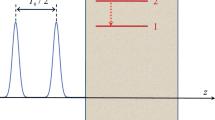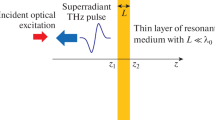Summary
We give a theoretical description of optical-pulse propagation through a resonant medium and superradiance and use various methods to obtain analytic solutions for the semi-classical equations which have been extensively employed in quantum optics. A criterion for nonlinear absorption is given, which depends on the amplitude and the rise-time of the input pulse, and the lifetime of the excited state and the relaxation time of the medium. Intensity-dependent absorption, compression of pulse duration and light amplification in saturable absorbers are demonstrated. We show that saturation occurs for an intense incident radiation field such that the medium becomes an optically thin system. Saturation also occurs for a long-rise-time incident pulse as shown in the study of propagation of step-function pulses. We obtain the maximal gain per unit length, and the maximal amplification and emission from a superradiant state which is only linearly proportional to the length of the medium, instead of an exponential dependence which would need so large an energy that the medium cannot provide it. We calculate the co-operative decay lifetime, the half-width of the Fourier spectrum and the field intensity of the co-operatively emitted radiation for certain cases. We also investigate self-induced transparency and derive an area theorem which is different from that of McCall and Hahn, though qualitatively similar to it.
Riassunto
Si dà una descrizione teorica della propagazione di un impulso ottico attraverso un mezzo risonante e della superradianza e si usano vari metodi per ottenere soluzioni analitiche per le equazioni semiclassiche che sono state ampiamente usate nell’ottica quantistica. Si dà un criterio per l’assorbimento non lineare, che dipende dall’ampiezza e dal tempo di salita dell’impulso d’entrata, dalla vita media dello stato eccitato e dal tempo di rilassamento del mezzo. Si dimostrano l’assorbimento dipendente del tempo, la compressione della durata dell’impulso e l’amplificazione della luce in assorbenti saturabili. Si dimostra che la saturazione avviene per un campo di radiazione incidente intenso tale che il mezzo diventa un sistema otticamente sottile. Si ha anche saturazione per un impulso incidente con lungo tempo di salita come è dimostrato nello studio della propagazione di impulsi con funzione a scalini. Si ottiene il guadagno massimo per unità di lunghezza e la massima amplificazione ed emissione per uno stato superradiante che è solo linearmente proporizonale alla lunghezza del mezzo, invece di una dipendenza esponenziale che avrebbe bisogno di un’energia così grande che il mezzo non è in grado di fornirla. Si calcola in alcuni casi la vita media del decadimento cooperativo, la semiampiezza dello spettro di Fourier e l’intensità di campo della radiazione emessa in cooperazione. Si studia anche la trasparenza autoindotta e si deduce un teorema di superficie che è diverso da quello di McCall e Hahn, quantunque qualitativamente simile ad esso.
Резюме
Мы предлагаем теоретическое описание распространения оптического импульса через резонансную среду и сверхсветимости. Мы используем различные методы для получения аналитических решений для полуклассических уравнений, которые широко применяются в квантовой оптике. Приводится критерий для нелинейного поглощения, который зависит от амплитуды и времени нарастания импульса на входе, времени жизни возбужденного состояния и времени релаксации среды. Показываются зависящие от интенсивности поглощение, сзатие длительности импульса и усиление света в насьщаемых поглотителях. Мы показываем, что насыщение имеет место для таких интенсивных падающих полей излучения, что среда становится оптически тонкой системой. Как показано при исследовании распространения импульсов в виде ступенчатойфункции, насыщение имеет место для больших времен нарастания начального импульса. Мы получаем максимальное прирашение на единицу длины, максимаИьное усиление и излучение из сверхизлучающего состояния, которое оказывается только линейно пропорциональным длине среды, вместо экспоненциальной зависимости, которая потребовала бы большого количества энергии, которое среда не может обеспечить. Мы вычисляем время кооперативного распада, полуширину фурье-спектра и интенсивность поля кооперативно испущенного излучения для некоторых случаев. Мы также исследуем самоиндуцированную прозрачность и выводим теорему, которая отличается от теоремы Мак Колла и Хана, хотя качественно аналогична ей.
Similar content being viewed by others
References
G. L. Lamb jr.:Rev. Mod. Phys.,43, 99 (1971);b)P. G. Kryukov andV. S. Letokhov:Sov. Phys. Usp.,12, 641 (1970).
S. Stenholm:Phys. Rep.,6, 1 (1973). See alsob)C. R. Stroud jr.,J. H. Eberly, W. L. Lama andL. Mandel:Phys. Rev. A,5, 1094 (1972);c)F. Haake andR. J. Glauber:Phys. Rev. A,5, 1457 (1972).
R. P. Feynman, F. L. Vernon andR. W. Hellworth:Journ. Appl. Phys.,28, 49 (1957).
F. T. Arecchi andR. Bonifacio:IEEE Journ. Quantum Electron.,1, 169 (1965).
C. L. Tang andB. D. Silverman: inPhysics of Quantum Electronics, edited byP. L. Kelly, B. Lax andP. E. Tannewald (New York, N. Y., 1966).
W. E. Lamb jr.:Phys. Rev.,134, A 1429 (1964).
A. Icsevgi andW. E. Lamb jr.:Phys. Rev.,185, 517 (1969).
S. L. McCall andE. L. Hahn:Phys. Rev.,183, 457 (1969).
For a review of light amplification see ref. (1b).
R. H. Dicke:Phys. Rev.,93, 99 (1954).
A. J. De Maria, W. H. Glenn jr.,M. J. Brienza andM. E. Mack:Proceedings of the IEEE,57, 2 (1969)
a)B. A. Lengyel:Lasers (New York, N. Y., 1971);b)P. P. Sorokin andJ. R. Lankard:IBM Journ. Res. Dev.,10, 162 (1966);P. P. Sorokin, J. R. Lankard, E. C. Hammond andV. L. Moruzzi:IBM Journ. Res. Dev.,11, 130 (1967).
a)H. M. Gibbs andR. E. Slusher:Phys. Rev. A,6, 2326 (1972);b)R. E. Slusher andH. M. Gibbs:Phys. Rev. A,5, 1634 (1972).
a)M. D. Crisp:Phys. Rev. A,1, 1604 (1970);b)M. D. Crisp:Phys. Rev. A,5, 1365 (1972).
N. G. Basov, R. B. Ambartsumyan, V. S. Zuev, P. G. Kryukov andV. S. Letokhov:Sov. Phys. JETP,23, 16 (1966).
D. A. Hutchinson andH. G. Hameka:Journ. Chem. Phys.,41, 2006 (1964);E. A. Power:Journ. Chem. Phys.,46, 4297 (1967);C. S. Chang andP. Stehle:Phys. Rev. A,4, 630 (1971).
a)I. D. Abella, N. A. Kurnit andS. R. Hartmann:Phys. Rev.,141, 391 (1966);b)F. T. Arecchi andE. Courtens:Phys. Rev. A,2, 1730 (1970);c)J. H. Eberly andN. E. Rehler:Phys. Lett.,29 A, 142 (1969);Phys. Rev. A,2, 1607 (1970);d)A. Compaan andI. D. Abella:Phys. Rev. Lett.,27, 23 (1971);e)A. M. Pont Goncalves, A. Tallet andR. Lefebvre:Phys. Rev.,188, 576 (1969);f)R. Bonifacio, P. Schwendiman andF. Haake:Phys. Rev. A,4, 302, 854 (1971);g)R. Friedberg andS. R. Hartmann:Phys. Lett.,38 A, 227 (1972).
F. A. Hopf andM. O. Scully:Phys. Rev.,179, 399 (1969).
a)D. C. Burnham andR. Y. Chiao:Phys. Rev.,188, 667 (1969);b)S. L. McCall jr.: Ph. D. Thesis, University of California, Berkeley, Cal., 1968 (unpublished).
E. P. Adams:Smithsonian Mathematical Formulae and Tables of Elliptic Functions (Washington, D. C., 1939).
G. N. Watson:Theory of Bessel Functions (Cambridge, 1966).
S. L. McCall andE. L. Hahn:Phys. Rev. A,2, 861 (1970).
E. U. Condon andG. H. Shortley:Theory of Atomic Spectra (Cambridge, 1959).
B. Senitzky, G. Gould andS. Cutler:Phys. Rev.,130, 1465 (1963).
see ref. (19a,b)a.
Krylov, Bogoliubov andMitropolsky.V. A. Belinskii andI. M. Khalatnikov:Sov. Phys. JETP,29, 911 (1969)
E. T. Copson:Asymptotic Expansions (Cambridge, 1967).
Author information
Authors and Affiliations
Additional information
Based in part on a thesis submitted in partial fulfilment of the requirements for the degree of Doctor of Philosophy at Columbia, University. Present address
Traduzione a cura della Redazione.
Переведено редакцией.
Rights and permissions
About this article
Cite this article
Su, JY. Pulse propagation and superradiance. Nuov Cim B 25, 59–77 (1975). https://doi.org/10.1007/BF02737665
Received:
Published:
Issue Date:
DOI: https://doi.org/10.1007/BF02737665




